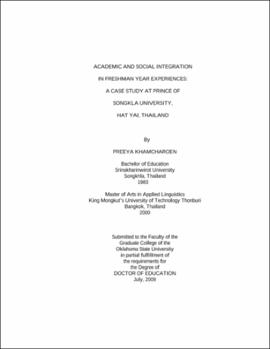| dc.contributor.advisor | Hyle, Adrienne E. | |
| dc.contributor.author | Khamcharoen, Preeya | |
| dc.date.accessioned | 2013-11-26T08:33:22Z | |
| dc.date.available | 2013-11-26T08:33:22Z | |
| dc.date.issued | 2009-07 | |
| dc.identifier.uri | https://hdl.handle.net/11244/7231 | |
| dc.description.abstract | Scope and Method of Study: The study explored the needs and experiences of freshman students to determine the congruence between what the institution provided for first-year students in the orientation program and what students needed to survive and succeed academically and socially in their freshman year. The study also aimed to seek voices from students' experiences to inform the university, providing useful information pertinent to the benefit of the orientation program. The theoretical framework employed as the analytical lens to understand the phenomenon was Tinto's (1993) model of student college persistence, specially focusing on the concepts of academic and social integration. The data sources were students, university staff members responsible for the orientation program, and documents relevant to the orientation program. The data were collected through student focus group interviews, university staff interviews, and document review. | |
| dc.description.abstract | Findings and Conclusions: Data collected from the study revealed that students had both academic and social needs to help them be successful in their freshman year. Regarding academic needs, they needed the knowledge about learning strategies and study skills, tutorial sessions, assistance from the instructors. Regarding social needs, they needed friends and activities The direct match between students' needs and what the university provided in the orientation was that their needs were responded in terms of social needs or social integration in joining the orientation program because the students had more opportunities to join activities and make friends with new friends and seniors or upperclass students. In terms of academic needs, though the needs were not directly matched, what the university provided in the orientation program was beyond student needs. The conclusions were that the concepts of academic and social integration can serve as a valuable framework to understand students' experiences and success in their freshman year, the qualitative methods were useful and study findings can be used to improve the orientation program by providing new activities and programs that will help students be successful academically and socially. | |
| dc.format | application/pdf | |
| dc.language | en_US | |
| dc.rights | Copyright is held by the author who has granted the Oklahoma State University Library the non-exclusive right to share this material in its institutional repository. Contact Digital Library Services at lib-dls@okstate.edu or 405-744-9161 for the permission policy on the use, reproduction or distribution of this material. | |
| dc.title | Academic and social integration in freshman year experiences: A case study at Prince of Songkla University, Hat Yai, Thailand | |
| dc.contributor.committeeMember | Harris, Edward L. | |
| dc.contributor.committeeMember | Stern, Kenneth A. | |
| dc.contributor.committeeMember | Bull, Kay | |
| dc.contributor.committeeMember | McClellan, Rhonda | |
| osu.filename | Khamcharoen_okstate_0664D_10397.pdf | |
| osu.accesstype | Open Access | |
| dc.type.genre | Dissertation | |
| dc.type.material | Text | |
| thesis.degree.discipline | Applied Educational Studies | |
| thesis.degree.grantor | Oklahoma State University | |
